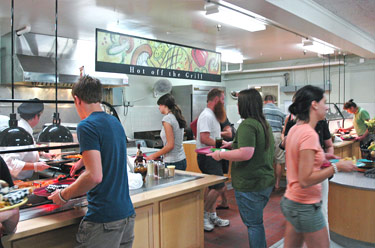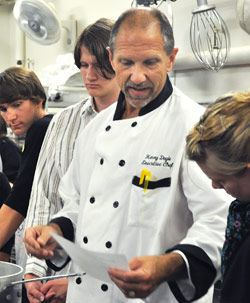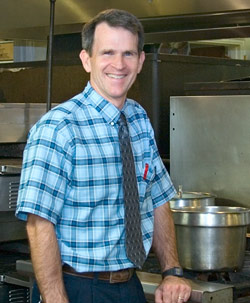Behind the Scenes at the Dining Hall
Visit almost any college and you are bound to hear students talking about the food served in the dining hall. Often, the remarks are along the line of how it is nothing like what Mom makes or that it is repetitive. Head Chef Henry Doyle and General Manager of Dining Services Mike Heffernan try to avoid hearing statements like these at Colby-Sawyer by listening to students and taking their suggestions.

Most diners are completely unaware of the work that goes into feeding the campus every single day. Right now, according to Heffernan, Dining Services employs about 60 people seven days a week who are busy bustling around the dining hall and kitchen from 5 a.m. until around 8:30 p.m.
“Until somebody has the opportunity to come into the kitchen to see what is happening, they don't fully understand what is going on there,” said Doyle who, along with Heffernan, are representatives of Sodexo, the company contracted to provide dining services to the college. “They don't know just how many people it took to make their dinner.”
A day in the life of the dining hall
The kitchen is clearly a busy place, and one that many students do not get to see. It is a maze filled with people, massive ovens and food. Everywhere you look there is something going on, with staff doing everything from peeling potatoes to creating desserts for dinner.
The kitchen staff actually seems small for the amount of food produced, and the task for this corps of individuals is monumental. They somehow feed more than 1,100 people three times a day.
Food deliveries arrive at the dining hall as early as 4 a.m., starting with the college's daily milk order. This order is followed by several others including produce, meats and beverages.

“These are pretty good-sized deliveries,” said Doyle. “We purchase about $30,000 worth of food products every week because that is how much the students eat.”
While the dining hall does not open until 7:30 a.m., it takes time to get everything up and running. Staff members begin arriving around 5 a.m. to warm the ovens and start prep work, like cutting vegetables and roasting the meat for lunch and dinner.
While the people in the kitchen are busy getting the meals started, those who work out front have big responsibilities, too. Tony Galluzzo, the friendly breakfast greeter, is responsible for switching on the coffee pots and plugging everything in. The student staff spends a lot of their time cleaning tables, replacing bagels and bread, and helping with the general operation of the dining hall.
Clean dishes are essential to the operation of the dining hall. The assembly line back to the dish-washing area is long and complex. It begins when the students put their dishes in the bins, which are then placed on the conveyor belt and taken out back. Out of sight, staff members clean and sanitize not only the dishware and silverware, but also the pots and pans that the kitchen staff uses. Once the whole operation begins, it runs full steam ahead right up until about 8:30 p.m.
“It's a well-oiled machine, and once it gets pumping along there is no slowing down,” said Doyle.
Lunch is offered beginning at 11:30 a.m., but the lunch cooks arrive four hours before to begin preparing the meal. The dining hall averages 750 to 800 people for lunch every day, so there is always plenty to do. After the lunch cooks have finished the meal for that day, they get a head start on the next day's work so that when they arrive the next morning whatever needs to be sliced, diced and put together is ready to go into the oven, pan or pot.
Dinner preparations begin around 11 a.m., as it takes three people four to five hours to get everything ready for the evening meal.
“We don't have the luxury of, say, a doctor's office, where they can make you sit and wait for an hour,” said Doyle. “When people want food or we are on a time frame; it's like an airplane taking off. It's got to be done on time. I'm really a stickler with these guys on having things out there early; when the students come in they are hungry and ready to roll.”
Planning Meals
The menu for the week's meals is already planned when it arrives on Doyle's desk from Sodexo headquarters, but he has the liberty to move things around when the meals become too repetitive.

“Those menus come down from Sodexo corporate,” said Heffernan. “ There is a student Board of Directors that meets during a week-long session to come up with things that students want to eat, so the menu is supposed to be coming from students.”
At the beginning of each week, Doyle and the production chefs meet to review the week's menu to ensure that it is not too similar to that of the week before. After the production meeting, Doyle sits down with the inventory sheet to take stock of the supplies on hand and how much food must be ordered for the upcoming week.
“I have an order guide, and I order what I need,” said Doyle. “If I figure we have 500 students who are going to eat at a meal where we are having turkey I have to find out exactly how much poundage we need for that particular meal.”
Members of the dining hall staff do an inventory sheet to keep track of every item in the house so that Doyle has a better idea of how much he needs to order.
“We know where the money is going,” said Heffernan. “When someone asks how many paper cups we go through in a week or something like that, we can look at the inventory and tell you the exact number that went out and how much they cost.”
In the days leading up to break the ordering process becomes more difficult, according to Doyle. If he orders too much it will spoil before students return, but if he orders too little there will not be enough food for the week.
Last year during the ice storm, one of the four walk-in refrigerators went down and $5,000 worth of stock had to be moved to a refrigerated truck that Doyle procured from one of the college's suppliers. Unfortunately, lot of milk and produce went bad because of the lack of electricity.
The loss of such a large amount of food has made Doyle careful about what he orders. He says that he wants things to be fresh for students, as if they just took it out of the refrigerator at home.
A taste of home
“We try to make the dining hall much like it is at home, where you would go to your fridge and take something out, prepare it and eat it,” said Heffernan.
The staff at the dining hall is always open to suggestions from anyone who uses the facility and encourage diners to use the comment cards so that they can respond to student suggestions to the best of their ability. One thing is for sure - it is a lot of work to prepare meals for over a thousand people, and the kitchen is never quiet for long.
“The kitchen never sleeps, there is constantly something happening,” said Doyle. “If we aren't cooking food then we are cleaning up or getting ready for the next day.”
-Amber Cronin '11


